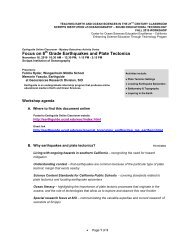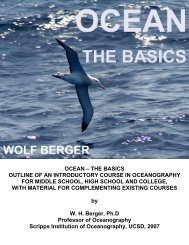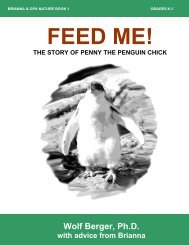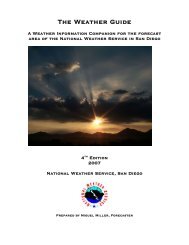Earth Science Pacing Guide ? 4 X 4 Block Schedule - Earthguide
Earth Science Pacing Guide ? 4 X 4 Block Schedule - Earthguide
Earth Science Pacing Guide ? 4 X 4 Block Schedule - Earthguide
Create successful ePaper yourself
Turn your PDF publications into a flip-book with our unique Google optimized e-Paper software.
<strong>Earth</strong> <strong>Science</strong> <strong>Pacing</strong> <strong>Guide</strong> – 4 X 4 <strong>Block</strong> <strong>Schedule</strong><br />
Week Standard Day Activity/Lab<br />
Page 1 of 10<br />
Unit 1: Introduction <strong>Earth</strong> <strong>Science</strong> – What, Why?<br />
1 Investigation and Experimentation 1:<br />
Scientific progress is made by asking<br />
meaningful questions and conducting careful<br />
investigations. As a basis for this<br />
understanding this concept and addressing<br />
the content in the other four strands,<br />
students should develop their own questions<br />
and perform investigations.<br />
1<br />
Class Expectations – Performance, behavior,<br />
concepts, skills<br />
Lab safety<br />
What is <strong>Earth</strong> <strong>Science</strong>? Why study <strong>Earth</strong> <strong>Science</strong>?<br />
Observing, measuring, analyzing data 2 Globe Fearon Handbook A<br />
How do you conduct a scientific<br />
Globe Fearon Handbook B<br />
investigation? Scientific Method/Lab<br />
Reports<br />
3<br />
4 Safety and Measurement Quiz<br />
Unit 2 - Astronomy – What place does the<br />
Week 2 – Formation and Change over time<br />
earth occupy in our solar system, our<br />
Week 3 – Stars and Sun<br />
galaxy, and our local group of galaxies?<br />
Week 4 – Solar System<br />
What structures do we see in the universe?<br />
What is the life cycle (including physics<br />
Week 5 – The Young <strong>Earth</strong><br />
and chemistry of fusion and radiation<br />
Movies: Nye Sun<br />
pressure) of stars, including our sun? How<br />
Nye Planets<br />
have the Sun and <strong>Earth</strong> changed over time?<br />
Nye Outer Space<br />
How do we know?<br />
Nye Meteors and Comets<br />
National Geographic Asteroids<br />
2 2b. Students know galaxies are made of<br />
Question: What things make up the universe?<br />
billions of stars and comprise most of the 1 Ac tivity: Modeling the expanding universe.<br />
visible mass of the universe. How and when If we can measure how fast the universe is<br />
did the universe form? What is a galaxy? & expanding, we can “run it backwards” to see what
2 2d. Students know that stars differ in their life<br />
cycles and that visual, radio, and X-ray<br />
telescopes may be used to collect data that<br />
reveal those differences. What is the life<br />
cycle of a star and how do we know?<br />
2 1e. Students know the Sun is a typical star and<br />
is powered by nuclear reactions, primarily<br />
the fusion of hydrogen to form helium.<br />
Where do the Sun and most other stars get<br />
Page 2 of 10<br />
their energy?<br />
3 2c. Students know the evidence indicating that<br />
all elements with an atomic number greater<br />
than that of lithium have been formed by<br />
nuclear fusion in stars. Where do all<br />
elements (other than hydrogen and helium<br />
from the Big Bang) form?<br />
3 2a. Students know the solar system is located<br />
in an outer edge of the disc-shaped Milky<br />
Way galaxy, which spans 100,000 light years.<br />
2<br />
3<br />
&<br />
4<br />
5<br />
1<br />
&<br />
2<br />
&<br />
3<br />
4<br />
happened in the past. Powers of 10 website.<br />
Read 18-10.<br />
Lab: Counting galaxies<br />
Homework: Holt chapt 30-4, pg 793<br />
Question: What is a star?<br />
Read 18-1<br />
Make a spectroscope page 439<br />
Read 18-2<br />
Exit slip: checking concepts<br />
Question: Do you think all stars are the same?<br />
Read 18-4<br />
Activity: building math skills, page 443<br />
Read 18-5<br />
Activity: Thinking critically, page 445<br />
Homework: Holt 30-2<br />
Question: What kind of star is the sun?<br />
Read 18-6<br />
Review Universe, galaxies, and stars<br />
Quiz: 5 questions<br />
Question: Where does almost all of the energy on<br />
<strong>Earth</strong> come from?<br />
Read 18-8<br />
Read chapter 2-1<br />
Activity: Draw atoms<br />
Go back to 18-8, Checking concepts<br />
Question: Where is <strong>Earth</strong> located in the universe?<br />
Read 17-1, 3, 4, 5<br />
Holt chapter 27.1, Group Activity – Spinning Nebula
What place does our galaxy occupy in the<br />
universe?<br />
3 1b. Students know the evidence from <strong>Earth</strong><br />
and moon rocks indicates that the solar<br />
system was formed from a nebular cloud of<br />
dust and gas approximately 4.6 billion years<br />
ago. When did the Solar System form?<br />
4 1a. Students know how the differences and<br />
similarities among the sun, the terrestrial<br />
planets, and the gas planets may have been<br />
established during the formation of the solar<br />
system. How did the solar system form?<br />
4 1c. Students know the evidence from<br />
geological studies of <strong>Earth</strong> and other planets<br />
suggest that the early <strong>Earth</strong> was very<br />
different from <strong>Earth</strong> today. How has <strong>Earth</strong><br />
Page 3 of 10<br />
changed over time?<br />
5 1d. Students know the evidence indicating<br />
that the planets are much closer to <strong>Earth</strong> than<br />
the stars are. How do we know the planets<br />
are closer to <strong>Earth</strong> than the stars?<br />
5 1f. Students know the evidence for the<br />
dramatic effects that asteroid impacts have<br />
had in shaping the surface of planets and<br />
their moons and in mass extinctions of life on<br />
<strong>Earth</strong>. What affects do asteroids have on<br />
<strong>Earth</strong> and Moon?<br />
5<br />
1<br />
&<br />
2<br />
Graphic page 686-687<br />
Graphic Organizer – Chain of Events chart<br />
Quiz – Formation of the solar system<br />
Holt 27.3 and 27.4<br />
C&C 17-5, 6, 8, 9<br />
Chapter 17 for week 4<br />
Read 16.6<br />
Activity: Observing parallax, pg 393<br />
Week 6 – Global Energy Budget<br />
Week 7 – Biogeochemical Cycles
Page 4 of 10<br />
Unit 3: Energy in <strong>Earth</strong>’s Systems– How do<br />
energy and resources move through <strong>Earth</strong>’s<br />
systems?<br />
6 1e. Students know the Sun is a typical star and<br />
is powered by nuclear reactions, primarily<br />
the fusion of hydrogen to form helium.<br />
What is the source of energy for the sun?<br />
6 4a. Students know the relative amount of<br />
incoming solar energy compared with<br />
<strong>Earth</strong>’s internal energy and the energy used<br />
by society.<br />
What is <strong>Earth</strong>’s main source of energy?<br />
6 4b. Students know the fate of incoming solar<br />
radiation in terms of reflection, absorption,<br />
and photosynthesis. What forms of energy<br />
are radiated by the sun? What happens to<br />
the sun’s energy when it hits <strong>Earth</strong>?<br />
6 5a. Students know how differential heating of<br />
<strong>Earth</strong> results in circulation patterns in the<br />
atmosphere and oceans that globally<br />
distribute the heat. How does differential<br />
heating impact <strong>Earth</strong>?<br />
7 7a. Students know the carbon cycle of<br />
photosynthesis and respiration and the<br />
nitrogen cycle. How does carbon move from<br />
GF 18<br />
H29<br />
Movies: Nye Water Cycle<br />
Nye Lakes and Ponds<br />
Nye Energy<br />
Nye Heat<br />
Nye Pollution Solutions<br />
Introduce fusion as the source of energy.<br />
Structure of sun and fusion process.<br />
• www.eo.ucar.edu<br />
• GF 18-8<br />
GF 11-3<br />
Graphic Organizer – percentages of where the sun’s<br />
energy goes<br />
Notes on conduction, convection, and radiation<br />
Change of phase lab (melt ice lab)<br />
temperature of soil and water lab<br />
GF 11-3 &11-4<br />
15.1 Globe Fearon (nitrogen and carbon cycle)
the atmosphere to the biosphere?<br />
7 7b. Students know the global carbon cycle: the<br />
different physical and chemical forms of<br />
carbon in the atmosphere, oceans, biomass,<br />
fossil fuels, and the movement of carbon<br />
among these reservoirs. Does the total<br />
Page 5 of 10<br />
amount of carbon on earth ever change?<br />
7 7c. Students know the movement of matter<br />
among reservoirs is driven by <strong>Earth</strong>’s<br />
internal and external sources of energy.<br />
Could the carbon cycle continue to run<br />
without energy?<br />
Unit 4: <strong>Earth</strong>’s Atmosphere - How is the<br />
atmosphere structured and how has it<br />
changed over time?<br />
8 8a. Students know the thermal structure and<br />
chemical composition of the atmosphere.<br />
What are the layers of the atmosphere?<br />
8 8b. Students know how the composition of<br />
<strong>Earth</strong>’s atmosphere has evolved over<br />
geologic time and know the effect of<br />
outgassing, the variations of carbon dioxide<br />
concentration, and the origin of atmospheric<br />
oxygen. Where did the carbon dioxide in<br />
<strong>Earth</strong>’s atmosphere come from and where<br />
15.1 Globe Fearon (nitrogen and carbon cycle)<br />
15.2 Globe Fearon – resources<br />
water cycle – 212/291<br />
Notebook 122<br />
Notebook 25.1<br />
Demo water pollution<br />
Week 8 – Structure of the atmosphere<br />
Week 9 – Composition of the atmosphere<br />
Movies: Nye Pressure<br />
An Inconvenient Truth<br />
BBC – The Weather (Wind)<br />
Foldable – layers of the atmosphere<br />
GF 11.1 and 11.2<br />
Demo air pressure: paint stir stick and cup of water<br />
with card<br />
Read section 22.3<br />
Lab: Evolution of <strong>Earth</strong>’s Atmosphere
did the oxygen in <strong>Earth</strong>’s atmosphere come<br />
from?<br />
8 8c. Students know the location of the ozone<br />
layer in the upper atmosphere, its role in<br />
absorbing ultraviolet radiation, and the way<br />
in which this layer varies both naturally and<br />
in response to human activities. What is the<br />
ozone layer and where is it located?<br />
9 5c. Students know the origin and effects of<br />
temperature inversions. What is a<br />
Page 6 of 10<br />
temperature inversion?<br />
9 5a. Students know how differential heating of<br />
<strong>Earth</strong> results in circulation patterns in the<br />
atmosphere and oceans that globally<br />
distribute the heat. How does differential<br />
heating effect the atmosphere?<br />
9 5b. Students know the relationship between<br />
the rotation of <strong>Earth</strong> and the circular motions<br />
of ocean currents and air in pressure centers.<br />
What is the Coriolis effect and how does it<br />
affect the atmosphere?<br />
9 4c. Students know the different atmospheric<br />
gases that absorb the <strong>Earth</strong>’s thermal<br />
radiation and the mechanism and<br />
significance of the greenhouse effect. What is<br />
the greenhouse effect?<br />
Unit 5: Climate and Oceanography- What<br />
are the key elements of the ocean systems<br />
Lab 11.1 – Temperature Inversion<br />
TWE 275 activity – combine with Lab 14.1<br />
(temperature of soil vs water – test soil, asphalt, etc at<br />
varying heights.)<br />
Lab: What’s the Matter with Air?<br />
Read sec 11-4 (GF)<br />
Demo: heat and spiral cut paper<br />
Dew and humidity pg 283 & 279<br />
Problem solving lab 283<br />
Lab 12.1 – Modeling the Coriolis effect<br />
Minilab 376 – greenhouse effect<br />
Week 10 – Weather and climate<br />
Week 11 – Climate
Page 7 of 10<br />
and what forces control them? How do the<br />
ocean and atmosphere interact to create our<br />
weather and climate?<br />
10 6a. Students know weather (in the short run)<br />
and climate (in the long run) involve the<br />
transfer of energy into and out of the<br />
atmosphere. How are weather and climate<br />
similar and different?<br />
10 6c. Students know how <strong>Earth</strong>’s climate has<br />
changed over time, corresponding to<br />
changes in <strong>Earth</strong>’s geography, atmospheric<br />
composition, and other factors, such as solar<br />
radiation and plate movement. What factors<br />
affect <strong>Earth</strong>’s climate cycles?<br />
11 6b. Students know the effects on climate of<br />
latitude, elevation, topography, and<br />
proximity to large bodies of water and cold<br />
or warm ocean currents. What are 5 main<br />
factors that influence an area’s climate?<br />
11 5e. Students know rain forests and deserts on<br />
<strong>Earth</strong> are distributed in bands at specific<br />
latitudes. What are the main climates zones<br />
and why would deserts and rain forests<br />
occur at specific latitudes?<br />
12 5d. Students know properties of ocean water,<br />
such as temperature and salinity, can be used<br />
to explain the layered structure of the oceans,<br />
the generation of horizontal and vertical<br />
ocean currents, and the geographic<br />
distribution of marine organisms. How do<br />
Week 12 - Oceanography<br />
Movies: Nye Oceans<br />
Nye Ocean Exploration<br />
Wind (GF) sec 11.7 & 11.8<br />
Climatograms<br />
Modeling 373<br />
Lab 24.1 – Cenozoic Ice Sheets and Plant Distribution<br />
Global warming pg 380<br />
Geolab 292 – Temperature/Pressure Relationships<br />
Geolab 378 – Microclimates<br />
Lab 14.2 – Classifying Climate<br />
Foldable - Global Wind Systems 302/269<br />
Refer to climatograms<br />
Lab 15.1 – Ocean Surface Temperature<br />
Minilab 394 – make sea water<br />
Problem solving 401 – tide chart graphing<br />
Vocab Tic-tac-toe
Page 8 of 10<br />
temperature and salinity affect the ocean?<br />
How do the oceans affect climate?<br />
Unit 6: Plate Tectonics – How do <strong>Earth</strong>’s<br />
structures change over time?<br />
13 3a. Students know features of the ocean floor<br />
(magnetic patterns, age, and sea-floor<br />
topography) provide evidence of plate<br />
tectonics. What is seafloor spreading and<br />
what features are formed?<br />
14 3b. Students know the principal structures<br />
that form at the three different kinds of plate<br />
boundaries. What structures form at plate<br />
boundaries?<br />
14 3c. Students know how to explain the<br />
properties of rocks based on the physical and<br />
chemical conditions in which they formed,<br />
including plate tectonic processes. At which<br />
type of plate boundary would you expect to<br />
find each type of rock – igneous,<br />
sedimentary, and metamorphic?<br />
15 3d. Students know why and how earthquakes<br />
occur and the scales used to measure their<br />
Week 13 – Seafloor features<br />
Week 14 – Plate Boundaries and Rocks<br />
Week 15 - <strong>Earth</strong>quakes<br />
Week 16 - Volcanoes<br />
Movies: Layers of the <strong>Earth</strong><br />
Nye <strong>Earth</strong>quakes<br />
Volcanoes powder keg<br />
National Geographic<br />
IMAX volcanoes of the deep<br />
Lab 17.1 – magnetism<br />
Lab 17.2 – subduction zone<br />
Geolab pg 464<br />
HW: Notebook 190<br />
Igneous rock worksheet<br />
Minilab pg 456<br />
Notebook 195-196<br />
Notebook 215-216<br />
Minilab 108<br />
Lab 5.2<br />
Minilab 126<br />
Lab 6.1<br />
Lab 6.2<br />
Geolab 464<br />
Demo convection with fish tank<br />
Vocab foldable<br />
Problem Solving Lab 502<br />
Geolab 516
Page 9 of 10<br />
intensity and magnitude. What are the three<br />
earthquake scales and how are they<br />
different?<br />
16 3e. Students know there are two kinds of<br />
volcanoes: one kind with violent eruptions<br />
producing steep slopes and the other kind<br />
with voluminous lava flows producing<br />
gentle slopes. What are the 2 main types of<br />
volcanoes and how are they different?<br />
Unit 7: California Geology –How do <strong>Earth</strong>’s<br />
processes impact California?<br />
17/18 9a. Students know the resources of major<br />
economic importance in California and their<br />
relation to California’s geology. What are<br />
California’s most important geologic<br />
resources?<br />
9b. Students know the principal natural<br />
hazards in different California regions and<br />
the geologic basis of those hazards. What<br />
and where are California’s geologic<br />
hazards?<br />
9c. Students know the importance of water to<br />
society, the origins of California’s fresh<br />
water, and the relationship between supply<br />
and need. Where are California’s water<br />
resources and needs, and how is this<br />
Culminating activity/webquest:<br />
Minilab 508<br />
HW: Notebook 221<br />
Lab 17.2<br />
Read Section 5.7 & 5.8 (GF)<br />
HW: pg 514 & Notebook 225<br />
Minilab pg 474<br />
Lab 18.2 – Volcanic eruption<br />
Demo viscosity<br />
HW: Notebook 210<br />
WebQuest: A New Improved California<br />
Webquest<br />
See California section of text<br />
NOTE: Jose Otero, seismologist, will do demos in<br />
class jdotero@ucsd.edu or sifo.ucsd.edu<br />
Webquest<br />
1 Webquest
Possible agents of change<br />
• Asteroid impact<br />
• Volcanic eruption<br />
• Ice sheet comes loose<br />
• Plate tectonics (plates coming together)<br />
• PT – mountain building<br />
Poster/storyboard/movie/comic book for 5 th grade audience<br />
Page 10 of 10


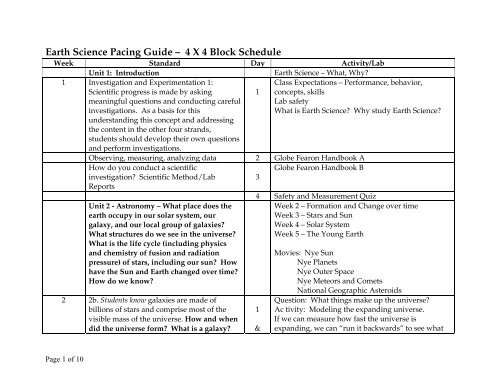
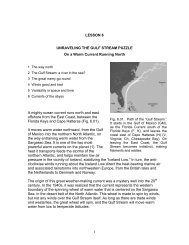

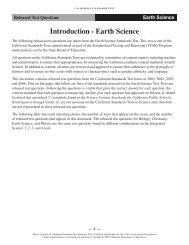
![Density Presentation 1 [.pdf] - Earthguide](https://img.yumpu.com/18214521/1/190x146/density-presentation-1-pdf-earthguide.jpg?quality=85)
